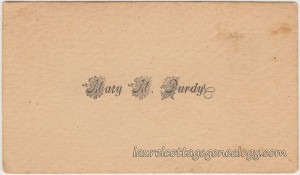“Ustick Ida. Feb 25 ’12. Dear Ms Baker we are well and like our home all o.k. We are having beautiful[?] weather jist like [?] With love to all from us. M F Rice” [?] (or with love to all from Ms [and] Mr Rice)
This one’s pretty hard to read, and yes, that really is Ustick, Idaho. An unusual name for a town, at first glance. There is a Martin and Annie Rice (married) living in Ustick in 1920, who could be the senders. I looked at the next U. S. Federal Census after 1912, as the note makes it sound like the couple or family had just moved there. The card is addressed to:
“Mrs. [or Mr?] W. D. Baker, 315 So. Bleaker, Lead, So. Dakota”
I then checked the 1910 in Lead, SD, thinking that the Rice family had been neighbors of the Baker family, and did find Martin and Anna Rice living at 302 Prospect Avenue in Lead. Martin was born about 1850 in Pennsylvania, and wife Anna, born about 1857 in Illinois. Martin’s occupation appears to be Assessor for either the county or city. The difference in the Lead addresses in 1910, for the Bakers and Rices, is only about a half mile.
While I think we can be relatively certain of the sender, the receiver of this postcard was identified for sure, in census records. William D. Baker was born about 1869 in Missouri. His wife, Annie E., was born about 1879 in Vermont, and their daughter, Ruth, was born about 1901 in South Dakota. They appear on the 1910 Federal Census at the same address as on this postcard. (So. Bleaker is S. Bleaker Street.) William’s occupation is Blacksmith in a gold mine.
This was an interesting card to research; unusual in that both the sender (well, certain enough to bet on it, if we were betting) and the receiver were found. As to the front of the card, it’s a great hand-tinted photo of a group of people, including some children, so maybe it was a family group, having an outing (or picnic!) on the banks of the St. Joe River. Moored next to them is a houseboat.
Ustick, Idaho, a town no longer in existence, was named after Dr. Harlan P. Ustick. There is also a Ustick Township, Illinois.
Divided back, used, hand-tinted postcard. Postmarked in Boise, Idaho on February 25, 1912. Publisher: Edward H. Mitchell, San Francisco, California. Made in the U.S.A.
Price: $8.00
Sources: Year: 1910; Census Place: Lead Ward 3, Lawrence, South Dakota; Roll: T624_1483; Page: 10A; Enumeration District: 0046; FHL microfilm: 1375496. (Ancestry.com)
Year: 1910; Census Place: Lead Ward 4, Lawrence, South Dakota; Roll: T624_1483; Page: 8A; Enumeration District: 0048; FHL microfilm: 1375496. (Ancestry.com)
Year: 1920; Census Place: Ustick, Ada, Idaho; Roll: T625_287; Page: 5B; Enumeration District: 29; Image: 571. (Ancestry.com)
http://localwiki.net/boise/ustick



















